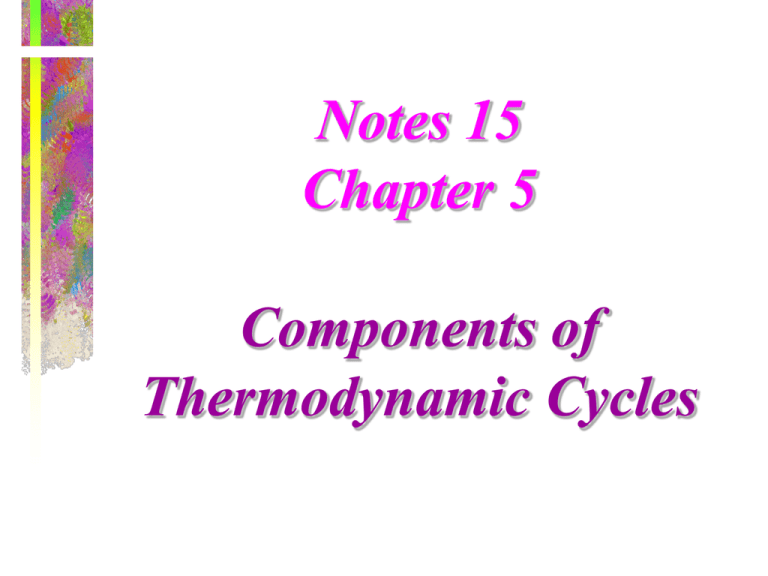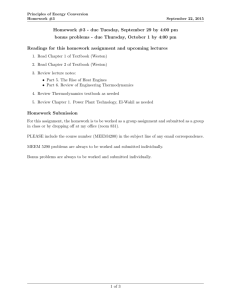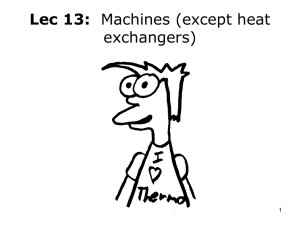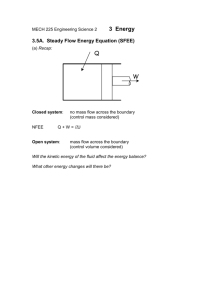Turbines, valves, compressors, pumps, heat exchangers
advertisement

Notes 15 Chapter 5 Components of Thermodynamic Cycles Components of Thermodynamic Cycles • What can be the components of thermodynamic cycles? • Turbines, valves, compressors, pumps, heat exchangers (evaporators, condensers), mixers, Open Systems Control Volume Where Exactly Are They Used? Vapor-cycle Power Plants Inside The Household Refrigerator Review of 1st Law V V q w ( h2 h1 ) g ( z 2 z1 ) 2 2 2 2 1 Applications to some steady state systems • Start simple – nozzles – diffusers – valves • Includes systems with power in/out – turbines – compressors/pumps • Finish with multiple inlet/outlet devices – heat exchangers – mixers You will need to use all that you’ve learned to date • • • • • • Conservation of mass Conservation of energy Property relationships Ideal gas equation of state Property tables Systematic analysis approach Nozzles and Diffusers • Nozzle--a device which accelerates a fluid as the pressure is decreased. V1, P1 V2, P2 This configuration is for sub-sonic flow. Nozzles and Diffusers • Diffuser--a device which decelerates a fluid and increases the pressure. V1, P1 V2, P2 For supersonic flow, the shape of the nozzle is reversed. Nozzles General shapes of nozzles and diffusers nozzle diffuser Subsonic flow nozzle diffuser Supersonic flow Common assumptions we’ll make for nozzles and diffusers • Steady state, steady flow • No work - device produces or uses shaft work • Heat loss/gain is often neglected • Potential energy change is usually small We start our analysis of diffusers and nozzles with the conservation of mass If we have steady state, steady flow, then: dm cv 0 dt And 1 m 2 m m We continue with conservation of energy 2 2 dEcv V V e [( hi he ) i Q W shaft m g ( zi ze )] 0 dt 2 We can simplify by dividing by mass flow: 0 V22 V12 q w ( h2 h1 ) g ( z 2 z1 ) 2 0 0 q = 0 (adiabatic) w = 0 (these are not work producing devices; neither is work done on them) We can rearrange to get a much simpler expression: V V ( h2 h1 ) 2 2 1 2 2 With a nozzle or diffuser, we are converting flow and internal energy, represented by Dh =D(u+Pv) into kinetic energy, or vice-versa. System Approach to Problem Solving • State assumptions for the device • Write basic form of conservation of mass and energy equations • Apply assumptions to get to previous equation V V ( h2 h1 ) 2 2 1 2 2 Sample Problem An adiabatic diffuser is employed to reduce the velocity of a stream of air from 250 m/s to 35 m/s. The inlet pressure is 100 kPa and the inlet temperature is 300°C. Determine the required outlet area in cm2 if the mass flow rate is 7 kg/s and the final pressure is 167 kPa. Sample problem: diagram and basic information INLET T1 = 300C P1 = 100 kPa V1 = 250 m/s m = 7 kg/s OUTLET Diffuser P2 = 167 kPa V2 = 35 m/s Sample Problem: Assumptions • SSSF (Steady state, steady flow) no time dependent terms • adiabatic • no work • potential energy is zero • air is ideal gas Sample Problem: apply basic equations Conservation of Mass 1 m 2 m m m Solve for A2 V1 A1 1 V2 A2 m 2 A2 V2 2 How do we get specific volumes? Remember ideal gas equation of state? P RT or RT1 1 P1 and RT2 2 P2 We know T1 and P1, so v1 is simple. We know P2, but what about T2? NEED ENERGY EQUATION!!!! Sample Problem:Energy Eqn V V q w ( h2 h1 ) g ( z 2 z1 ) 2 2 2 V V ( h2 h1 ) 2 2 1 2 1 2 2 V1 and V2 are given. We need h2 to get T2 and v2. If we assumed constant specific heats, we could get T2 directly V V c p (T2 T1 ) 2 2 1 2 2 Sample problem - con’t However, I’m going to use variable specific heats.. we get h1 from air tables at T1 = 300 + 273 = 573K. kJ h1 578.73 kg From energy equation: kJ ( 250 )2 ( 35 )2 m 2 3 kJ s 2 2 10 h2 578.73 2 kg 2 kg m s kJ h2 609.4 kg This corresponds to an exit temperature of 602.2 K. Now we can get solution. 3 RT2 m 2 1.0352 P2 kg and m 2 A2 V2 kg m3 1.0352 s kg 7 2 m 4 m 35 10 2 s cm A2 2070 cm 2 Throttling Devices (Valves) Typical assumptions for throttling devices • No work • Potential energy changes are zero • Kinetic energy changes are usually small • Heat transfer is usually small • Two port device Look at energy equation: Apply assumptions from previous page: 0 0 0 0 V V q w ( h2 h1 ) g ( z 2 z1 ) 2 We obtain: or 2 2 2 1 ( h2 h1 ) 0 h2 h1 Discussion Question Does the fluid temperature increase, decrease, or remain constant as it goes through an adiabatic valve? Look at implications: If the fluid is liquid/vapor in equilibrium: During throattling process: h const. T P const. • The pressure drops, • The temperature drops, h const. s • Enthalpy is constant Look at implications: If fluid is an ideal gas: ( h2 h1 ) C p ( T2 T1 ) 0 Cp is always a positive number, thus: T2 T1 TEAMPLAY Refrigerant 12 enters a valve as a saturated liquid at 0.9607 Mpa and leaves at 0.1826 MPa. What is the quality and the temperature of the refrigerant at the exit of the valve? TEAMPLAY Liquid R12 State (1) Liquid saturated, x=0 Psat = 0.9607 MPa Tsat = ? Hliq = ? Liquid + Vapor R12 State (2) Liquid+vapor, x=? Psat = 0.1826 MPa Tsat = ? Hliq = ? Turbine • A turbine is device in which work is produced by a gas passing over and through a set of blades fixed to a shaft which is free to rotate. m in m out W CV TURBINES We’ll assume steady state, V22 V12 q w ( h2 h1 ) g ( z 2 z1 ) 2 Sometimes Almost neglected always neglected q w ( h2 h1 ) Turbines • We will draw turbines like this: inlet w maybe q outlet Compressors, pumps, and fans • Machines developed by engineers to make life easier, decrease world anxiety, and provide exciting engineering problems from the industrial revolution for students. • Machines which do work on a fluid to raise its pressure, potential, or speed. • Mathematical analysis proceeds the same as for turbines, although the signs may differ. Primary differences • Compressor - used to raise the pressure of a compressible fluid • Pump - used to raise pressure or potential of an incompressible fluid • Fan - primary purpose is to move large amounts of gas, but usually has a small pressure increase Compressors, pumps, and fans Compressor Side view of pump End view of pump Sample Problem Air initially at 15 psia and 60°F is compressed to 75 psia and 400°F. The power input to the air is 5 hp and a heat loss of 4 Btu/lbm occurs during the process. Determine the mass flow in lbm/min. Draw Diagram 15 psia 60oF Compressor Wshaft = 5 hp 75 psia 400oF Q = 4 Btu/lb Assumptions • • • • Steady state steady flow (SSSF) Neglect potential energy changes Neglect kinetic energy changes Air is an ideal gas What do we know? INLET T1 = 60F P1 = 15 psia OUTLET T2 = 400F P2 = 75 psia Apply First Law: 0 0 0 0 2 2 V V 1 2 h1 h2 Q - Wshaft m gz1 m gz2 0 2 2 Simplify and rearrange: q W shaft m (h2 h1 m m W shaft q (h2 h1 Continuing with the solution.. Get h1 and h2 from air tables Btu h1 124.27 lbm Btu h2 206.46 lbm Follow through with solution ft lbf 60s ( 5hp 550 hp s min m Btu Btu ft lbf (206.46 124.27 4 778 lbm lbm Btu lbm m 2.46 min Heat Exchangers and mixing devices • Heat exchangers are devices which transfer heat between different fluids • Mixing devices (also called open heat exchangers) combine two or more fluids to achieve a desired output, such as fluid temperature or quality Heat exchangers are used in a variety of industries • • • • • Automotive - radiator Refrigeration - evaporators/condensers Power production - boilers/condensers Power electronics - heat sinks Chemical/petroleum industry- mixing processes Heat Exchangers Condenser/evaporator for heat pump Something a little closer to home.. Heat Exchangers • Now, we must deal with multiple inlets and outlets: m 4 m 2 m 1 m 3 Question…... • At steady flow, what is the relationship between 1, m 2, m 3 , and m 4? m Conservation of Mass What assumptions to make? • See any devices producing/using shaft work? • What about potential energy effects? • What about kinetic energy changes? • Can we neglect heat transfer? Apply conservation of mass on both streams... If we have steady flow, then: m 4 dm cv 0 dt m 2 m 1 And 1 m 2m A m 3 m 4 m B m Fluid A m 3 Fluid B Conservation of energy can be a little more complicated... I’ve drawn the control volume around the whole heat exchanger. Implications: No heat transfer from the control volume. m 4 m 2 m 1 Fluid A m 3 Fluid B Heat Exchangers • Now if we want the energy lost or gained by either fluid we must let that fluid be the control volume, indicated by the red. m 2 1 m A m Conservation of energy looks pretty complicated: Q WCV 2 2 V1 V3 1 h1 3 h3 m gz1 m gz3 2 2 V22 V42 2 h2 4 h4 m gz2 m gz4 0 2 2 We know from conservation of mass: 1 m 2 m A m 3 m 4 m B m Conservation of energy for the heat exchanger Apply what we know about the mass flow relationships: Q WCV V12 V22 A (h1 h2 m g (z1 z2 2 2 A V32 V42 B (h3 h4 m g (z3 z4 0 2 2 B Heat Exchangers • Generally, there is no heat transfer from or to the overall heat exchanger, except for that leaving or entering through the inlets and exits. • So, Q 0 • And, the device does no work, W CV 0 • Also, potential and sometimes kinetic energy changes are negligible. Heat Exchangers 0 0 Q W CV V12 V22 A (h1 h2 m g (z1 z2 2 2 A 0, (sometimes 0, (usually negligible) negligible) V32 V42 B (h3 h4 m g (z3 z4 0 2 2 B 0, (sometimes 0, (usually negligible) negligible) Heat Exchangers • And we are left with A ( h1 h2 ) m B ( h4 h3 ) m The energy change of fluid A is equal to the negative of the energy change in fluid B. QUESTION….. How would the energy equation differ if we drew the boundary of the control volume around each of the fluids? Heat Exchangers The energy equation for one side: A (h1 h2 0 QCV , A m Or dividing through by the mass flow: q A h2 h1 Example Problem Refrigerant 134a with a mass flow rate of 5 kg/min enters a heat exchanger at 1.2 MPa and 50C and leaves at 1.2 MPa and 44C. Air enters the other side of the heat exchanger at 34 C and 101 kPa and leaves at 42 C and 101 kPa. Calculate: a) the heat transfer from the refrigerant b) the mass flow rate of the air Draw diagram AIR OUTLET T3=42C P3 = 101 kPa Ref 5 kg / min m R-134a INLET R-134a OUTLET T2=44C P2 = 1.2 MPa AIR INLET T3=34C P3 = 101 kPa T1=50C P1 = 1.2 MPa air ? m State assumptions • • • • • Steady state, steady flow No work Air is ideal gas Kinetic energy change is zero Potential energy change is zero Start analysis with R-134a 0 Q Ref WCV 0 0 V22 V12 Ref [( h2 h1 ) m g ( z2 z1 )] 2 Apply assumptions Ref ( h2 h1 ) Q Ref m We can get h1 and h2 from tables. The refrigerant mass flow is given. From R-134a tables h1 = 275.52 kJ/kg h2 = 112.22 kJ/kg Plugging back into energy equation: kg kJ QRef 5 ( 112.22 275.52 ) min kg Q Ref kJ 816.5 min On to part (b) of the problem We want to get the mass flow of the air... Start by writing the energy equation for the air side: 0 Q air WCV 0 0 V42 V32 air[( h4 h3 ) m g ( z4 z3 )] 2 Simplify air ( h4 h3 ) Qair m Sample Problem, Con’t If air is an ideal gas, then we can rewrite the enthalpy difference as: airC p (T4 T3 ) Q air m Rearrange to solve for mass flow: Q air m air C p (T4 T3 ) How do we get the heat transfer rate to/from the air? Almost there!!!!! We can write: Q air Q ref Q air 816.5 kJ / min Get specific heat from table: Cp = 1.006 kJ/kg.K kJ 816.5 kg min m air 101.4 kJ min (1.006 )(42 34 )K kgK





